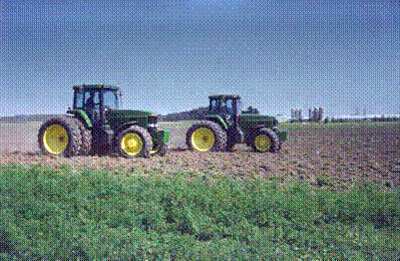Proper tire pressure reduces fuel consumption, field time and soil compaction
Inflating tractor tires properly is a quick and easy way to save fuel and time during field operations and reduce yield-limiting soil compaction.
With diesel fuel prices hovering above $4 per gallon and fall field work approaching, producers are looking for ways to improve tractor performance and fuel efficiency. One of the quickest and easiest ways to accomplish this is to inflate radial tires to the lowest recommended pressure for the load they carry. A survey conducted in Oklahoma found that only 45 percent of the tractor tires were within the recommended tire inflation ranges. The benefits of proper tire inflation are clearly depicted in Image 1. This photograph was taken during a field demonstration at Michigan State University’s Ag Expo where identical tractors were hitched with a cable and pulley system to a third tractor pulling a high-draft tillage tool. The front tractor with properly inflated tires consistently performed better than the trailing tractor with slightly over inflated tires.

Image 1. Tire inflation demonstration at MSU’s Ag Expo.
Photo credit: Tim Harrigan, MSU
The USDA Agricultural Research Service reported that properly inflated tires generate nearly 25 percent more pull than tires inflated at higher pressures. This means that tractors equipped with properly inflated tires have the potential to reduce fuel consumption and field time.
Properly inflated tires will also reduce the depth and degree of compaction in the top foot of soil (surface compaction). Soybeans are affected by surface compaction to a greater extent than corn. Compaction reduces soybean yields by limiting root growth, reducing nodulation, inhibiting potassium and phosphorus uptake and promoting diseases such as sudden death syndrome and Phytophthora root and stem rot.
Michigan State University Extension recommendations for properly inflating tires are listed below:
- Weigh each axle after the tractor has been properly ballasted. If fully mounted equipment will be transported, weigh the rear axle with the equipment in the raised position. If liquid manure tanks or grain carts will be towed, add the loaded tongue weight of the equipment to the rear axle weight. Manufacturers can provide this information. Determine the weight carried per tire by dividing the axle weight by the number of tires mounted on the axle.
- Use load and inflation tables available from the tire manufacturer and inflate tires to the lowest recommended pressure for the weight carried per tire. Always use the manufacturer’s recommendations for your tire configuration (single, dual or triple) on each axle. Adjust inflation pressures whenever axle loads change.
- Use a high quality tire gauge that is easy to read, accurate, consistent and graduated in at least one psi increments. Gauges designed for use on ATV tires are recommended. Digital, pencil and dial gauges will all work, however, dial gauges tend to be the most easily damaged when dropped.
- Check the inflation pressure often when the tires are cold, preferably in the morning. Gauge readings can be 1 to 3 psi higher when the tires are warm.
- If fluid ballast has been added to the tires, measure inflation pressure with valve stems in the same position for all tires. Pressures at the bottom of the tire can be 1.5 psi higher than at the top.
- For optimum performance, set all tires on an axle to the same pressure.
By properly inflating radial tires you will reduce fuel consumption, finish your field work in less time and take an important step toward limiting surface soil compaction.
This article was produced by the SMaRT project (Soybean Management and Research Technology). The SMaRT project was developed to help Michigan producers increase soybean yields and farm profitability. Funding for the SMaRT project is provided by MSU Extension and the Michigan Soybean Checkoff program.



 Print
Print Email
Email


